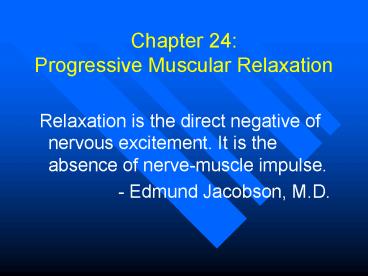Chapter 24: Progressive Muscular Relaxation PowerPoint PPT Presentation
1 / 10
Title: Chapter 24: Progressive Muscular Relaxation
1
Chapter 24Progressive Muscular Relaxation
- Relaxation is the direct negative of nervous
excitement. It is the absence of nerve-muscle
impulse. - - Edmund Jacobson, M.D.
2
Progressive Muscular Relaxation
- Muscles respond
- to thoughts of perceived threats
- with tension or contraction
- Muscular tension
- the most common symptom of stress
- can lead to
- stiffness, pain, discomfort, distorted and
disaligned posture and joint stability
3
Progressive Muscular Relaxation
- The building blocks involved in muscular
contraction are a motor end unit, a motor nerve
fiber (neuron), a skeletal muscle fiber, and a
stimulus from the nerve fiber to the muscle fiber
called an action potential. - Chemical released from these neurons are
neurotrophic substances. - Neurotransmitters secrete epinephrine,
norepinephrine, and ACh to regulate and control
muscle contraction.
4
Progressive Muscular Relaxation
- Muscles can contract in one of three ways
- concentrically (shortening)
- eccentrically (lengthening)
- isometrically (no visible change in length)
5
Progressive Muscular Relaxation
- Muscle tension
- produced through the stress response
- primarily isometric
- Over time, muscles
- contracted isometrically
- begin to show signs of shortening
6
Progressive Muscular Relaxation
- Systematic approach to relieving muscle tension
- Edmund Jacobson
- a simple technique used to promote rest and
relaxation - by systematically tensing and relaxing the bodys
musculature, from feet to the head
7
Benefits of PMR
Reduced muscle tension deepened sense
of relaxation
Increased awareness of muscle tension
Decreased levels of muscle tension
8
Steps of Initiate PMR
- Comfortable position
- Monitoring your breathing
- Inhale when you contract each muscle group
- Exhale when you relax each muscle group
- Focus your concentration on each muscle group as
you work regions of your body
9
Typical phase for each muscle group using PMR
- First contraction 100 _at_ 5-10 seconds
- release and relax (exhale)
- compare relaxation to contraction
- Second contraction 50 _at_ 5-10 seconds
- release and relax (exhale)
- compare relaxation to contraction
- Third contraction 5-10 _at_ 5-10 seconds
- release and relax (exhale)
- compare relaxation to contraction
10
Progressive Muscular Relaxation
Research, specifically biofeedback using
electromyography, proves that this technique
reduces muscular tension.

